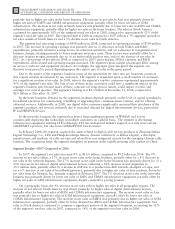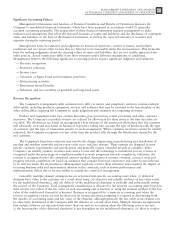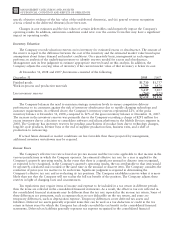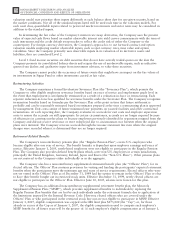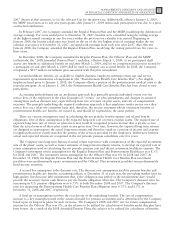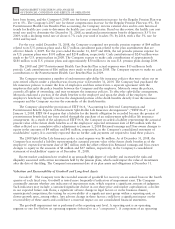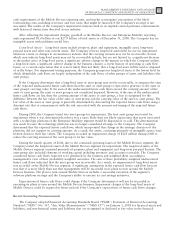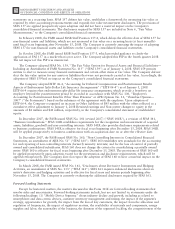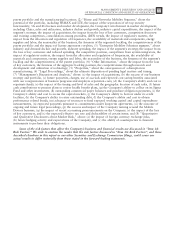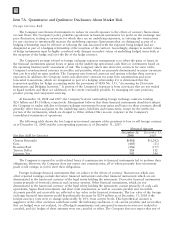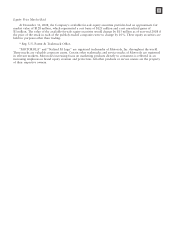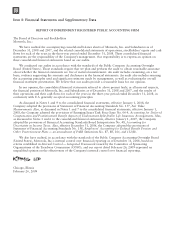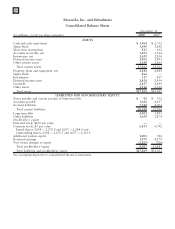Motorola 2008 Annual Report Download - page 82
Download and view the complete annual report
Please find page 82 of the 2008 Motorola annual report below. You can navigate through the pages in the report by either clicking on the pages listed below, or by using the keyword search tool below to find specific information within the annual report.
discount rate of 25% to the Mobile Devices reporting unit commensurate with development stage enterprises or
turnaround opportunities. The Company believes this rate reflects the inherent uncertainties of the Mobile Devices
reporting unit’s projected cash flows. The Company evaluated the merits of each significant assumption, both
individually and in the aggregate, used to determine the fair value of the reporting units, as well as the fair values
of the corresponding assets and liabilities within the reporting units, and concluded they are reasonable.
Based on the results of Step One of our annual assessment of the recoverability goodwill, the fair values of the
Home, Public Networks and Government and Public Safety reporting units exceeded their carrying values,
indicating that there was no impairment of goodwill at these reporting units. The discount rate would need to be
increased by 5.6% for the Home reporting unit, 12.1% for the Public Networks reporting unit and 22.0% for the
Government and Public Safety reporting unit before the fair values of those reporting units would be less than their
fair values. The Company does not believe the resulting discount rates would be reasonable relative to the risks
associated with the future cash flows of these businesses.
However, the fair values of the Enterprise Mobility and Mobile Devices reporting units were below their
respective book values, indicating a potential impairment of goodwill and the requirement to perform Step Two of
the analysis for these reporting units. The Company acquired the main components of the Enterprise Mobility
reporting unit in 2007 at which time the book value and fair value of the reporting unit was the same. Because of
this fact, the Enterprise Mobility reporting unit was most likely to experience a decline in its fair value below its
book value as a result of lower values in the overall market and the deteriorating macroeconomic environment and
the market’s view of its near term impact on the reporting unit. The decline in the fair value of the Mobile Devices
reporting unit below its book value is a result of the deteriorating macroeconomic environment, lower expected
sales and cash flows as a result of the decision to consolidate platforms announced in the fourth quarter of 2008,
and the uncertainty around the reporting unit’s future cash flows.
The allocation of the fair value of the reporting units to individual assets and liabilities within the reporting
units also requires us to make significant estimates and assumptions. The allocation requires several analyses to
determine fair value of assets and liabilities including, among others, definite lived intangible assets, pre-paid
assets, deferred taxes and current replacement costs for certain property, plant and equipment.
Based on the results of the hypothetical purchase price allocation in Step Two for the Enterprise Mobility and
Mobile Devices reporting units, the implied fair value of goodwill was $0 for Mobile Devices and $1.0 billion for
Enterprise Mobility. As a result, the Company reduced the recorded value of goodwill by $55 million at the
Mobile Devices reporting unit (representing all of its goodwill) and $1.6 billion at the Enterprise Mobility
reporting unit during the three-month period ended December 31, 2008.
A further deterioration in the Enterprise Mobility reporting unit’s operating results or projected cash flows in
the future could result in additional impairment charges to goodwill. In addition, changes in certain assumptions in
the current analysis could have a significant impact on the goodwill impairment charge recorded in the fourth
quarter of 2008 for the Enterprise Mobility reporting unit. For example, a 2% decrease in the forecasted EBIT
would result in an increase to the goodwill impairment charge of approximately $194 million, and a 100 basis
point increase in the discount rate would result in an increase to the goodwill impairment charge of approximately
$187 million. The sensitivity amounts above are calculated based on the impact of the change in the fair value of
the Enterprise Mobility reporting unit, as well as the impact of changes in the fair values of the assets and
liabilities of the Enterprise Mobility reporting unit.
The accounting principles regarding goodwill acknowledge that the observed market prices of individual
trades of a company’s stock (and thus its computed market capitalization) may not be representative of the fair
value of the company as a whole. Additional value may arise from the ability to take advantage of synergies and
other benefits that flow from control over another entity. Consequently, measuring the fair value of a collection of
assets and liabilities that operate together in a controlled entity is different from measuring the fair value of that
entity’s individual common stock. In most industries, including ours, an acquiring entity typically is willing to pay
more for equity securities that give it a controlling interest than an investor would pay for a number of equity
securities representing less than a controlling interest.
For the purpose of determining the implied control premium calculation in the overall goodwill analysis, the
Company applied assumptions, including for determining the fair value of corporate assets. Corporate assets
primarily consist of cash and cash equivalents, Sigma Fund balances, short-term investments, investments, deferred
tax assets and corporate facilities. Judgments about the fair value of corporate assets include, among others, an
assumption that deferred tax assets should be discounted to reflect their economic lives, that a significant portion
of the corporate assets are required to pay off debt, fund the Company’s retirement obligations, meet the near term
74 MANAGEMENT’S DISCUSSION AND ANALYSIS
OF FINANCIAL CONDITION AND RESULTS OF OPERATIONS


